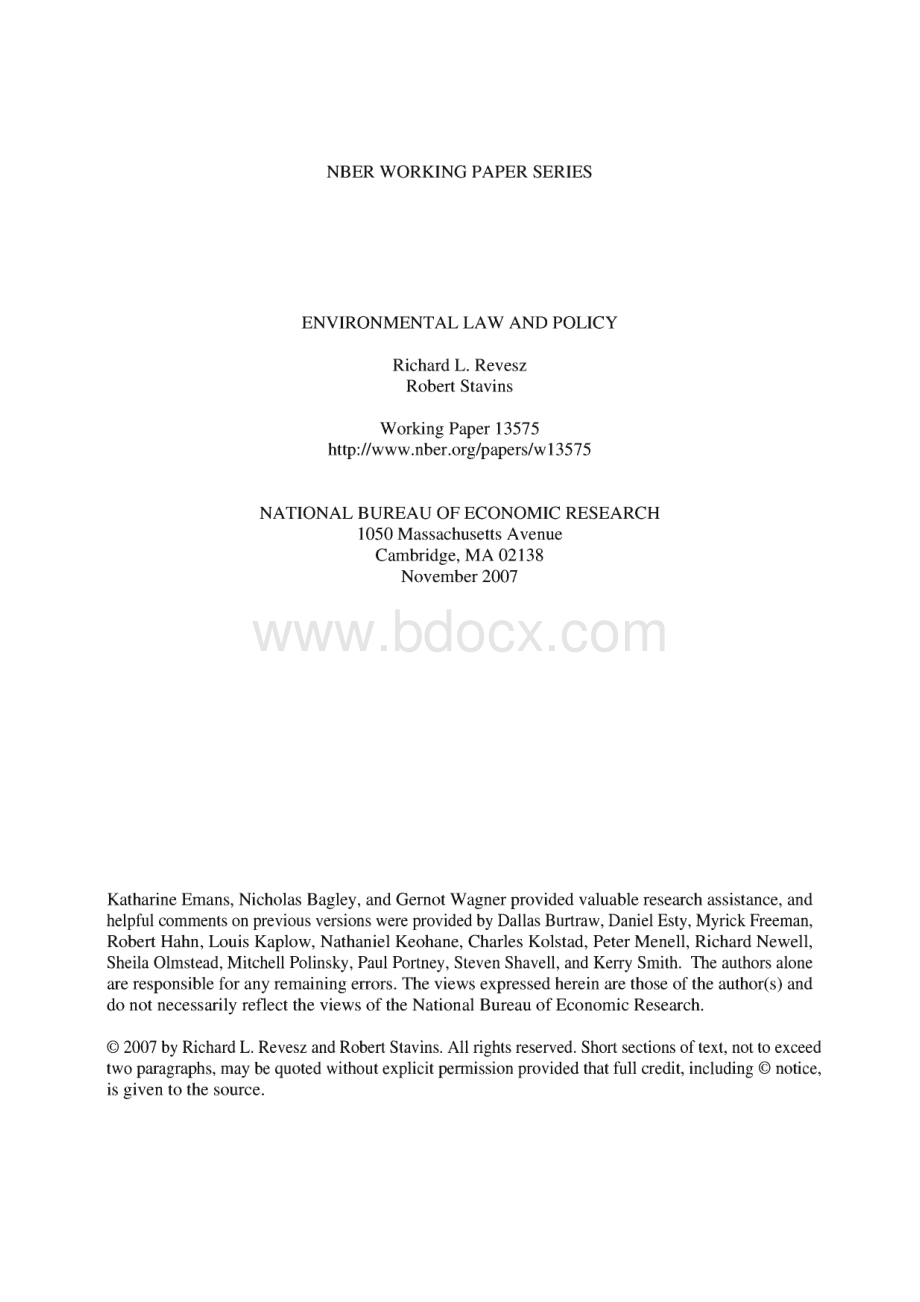Environmental Law and Policy.pdf
《Environmental Law and Policy.pdf》由会员分享,可在线阅读,更多相关《Environmental Law and Policy.pdf(97页珍藏版)》请在冰豆网上搜索。

NBERWORKINGPAPERSERIESENVIRONMENTALLAWANDPOLICYRichardL.ReveszRobertStavinsWorkingPaper13575http:
/www.nber.org/papers/w13575NATIONALBUREAUOFECONOMICRESEARCH1050MassachusettsAvenueCambridge,MA02138November2007KatharineEmans,NicholasBagley,andGernotWagnerprovidedvaluableresearchassistance,andhelpfulcommentsonpreviousversionswereprovidedbyDallasBurtraw,DanielEsty,MyrickFreeman,RobertHahn,LouisKaplow,NathanielKeohane,CharlesKolstad,PeterMenell,RichardNewell,SheilaOlmstead,MitchellPolinsky,PaulPortney,StevenShavell,andKerrySmith.Theauthorsaloneareresponsibleforanyremainingerrors.Theviewsexpressedhereinarethoseoftheauthor(s)anddonotnecessarilyreflecttheviewsoftheNationalBureauofEconomicResearch.2007byRichardL.ReveszandRobertStavins.Allrightsreserved.Shortsectionsoftext,nottoexceedtwoparagraphs,maybequotedwithoutexplicitpermissionprovidedthatfullcredit,includingnotice,isgiventothesource.EnvironmentalLawandPolicyRichardL.ReveszandRobertStavinsNBERWorkingPaperNo.13575November2007JELNo.K32,Q28,Q38,Q48ABSTRACTThischapterfortheHandbookofLawandEconomicsprovidesaneconomicperspectiveofenvironmentallawandpolicy.Weexaminetheendsofenvironmentalpolicy,thatis,thesettingofgoalsandtargets,beginningwithnormativeissues,notablytheKaldor-Hickscriterionandtherelatedmethodofassessmentknownasbenefit-costanalysis.Weexaminethisanalyticalmethodindetail,includingitstheoreticalfoundationsandempiricalmethodsofestimationofcompliancecostsandenvironmentalbenefits.Wereviewcritiquesofbenefit-costanalysis,andexaminealternativeapproachestoanalyzingthegoalsofenvironmentalpolicies.Weexaminethemeansofenvironmentalpolicy,thatis,thechoiceofspecificpolicyinstruments,beginningwithanexaminationofpotentialcriteriaforassessingalternativeinstruments,withparticularfocusoncost-effectiveness.Thetheoreticalfoundationsandexperientialhighlightsofindividualinstrumentsarereviewed,includingconventional,command-and-controlmechanisms,market-basedinstruments,andliabilityrules.Threecross-cuttingissuesreceiveattention:
uncertainty;technologicalchange;anddistributionalconsiderations.Weidentifynormativelessonsinregardtodesign,implementation,andtheidentificationofnewapplications,andweexaminepositiveissues:
thehistoricaldominanceofcommand-and-control;theprevalenceinnewproposalsoftradeablepermitsallocatedwithoutcharge;andtherelativelyrecentincreaseinattentiongiventomarket-basedinstruments.Wealsoexaminethequestionofhowenvironmentalresponsibilityisandshouldbeallocatedamongthevariouslevelsofgovernment.WeprovideapositivereviewoftheresponsibilitiesofFederal,state,andlocallevelsofgovernmentintheenvironmentalrealm,plusanormativeassessmentofthisallocationofregulatoryresponsibility.WefocusonthreeargumentsthathavebeenmadeforFederalenvironmentalregulation:
competitionamongpoliticaljurisdictionsandtheracetothebottom;transboundaryenvironmentalproblems;andpublicchoiceandsystematicbias.RichardL.Revesz110WestThirdStreet,Room218NewYork,NY10012reveszturing.law.nyu.eduRobertStavinsJFKSchoolofGovernmentHarvardUniversity79JFKStreetCambridge,MA02138andNBERrobert_stavinsharvard.eduTABLEOFCONTENTS1.INTRODUCTION.12.SETTINGGOALSANDTARGETS:
THEENDSOFENVIRONMENTALPOLICY.42.1NormativeIssuesandAnalysis.42.1.1CriteriaforEnvironmentalPolicyEvaluation.42.1.2Benefit-CostAnalysisofEnvironmentalRegulations.72.1.2.1Discounting.72.1.2.2BenefitConceptsandTaxonomies.92.1.2.3CostConceptsandTaxonomies.102.1.2.4CostEstimationMethods.112.1.2.5BenefitEstimationMethods.122.1.2.5.1RevealedPreferenceMethods.122.1.2.5.2StatedPreferenceMethods.172.1.2.5.3FallaciousMethodsofBenefitEstimation.192.1.2.5.4BenefitTransfer.192.1.2.5.5ValuingMortalityRiskReductions.202.1.2.6CritiquesofBenefit-CostAnalysis.222.1.3OtherApproachestoAnalyzingtheGoalsofEnvironmentalPolicies.232.2PositiveIssuesandAnalysis.252.2.1ExecutiveOrders.252.2.2LegislativeEnactments.262.2.3JudicialRecognition.302.2.4APoliticalEconomyPerspectiveonHowStandardsAreSet.303.CHOOSINGINSTRUMENTS:
THEMEANSOFENVIRONMENTALPOLICY.313.1NormativeIssuesandAnalysis.313.1.1PotentialCriteriaforChoosingAmongPolicyInstruments.323.1.2AlternativePolicyInstruments.333.1.2.1Command-and-ControlversusMarket-BasedInstruments.343.1.2.2PollutionCharges.353.1.2.3TradeablePermitSystems.373.1.2.4MarketFrictionReduction.403.1.2.5GovernmentSubsidyReduction.413.1.2.6LiabilityRules.413.1.2.6.1JointandSeveralversusNon-JointLiability.433.1.2.6.2LiabilityExtension.433.1.3Cross-CuttingIssues.453.1.3.1ImplicationsofUncertaintyforInstrumentChoice.453.1.3.2EffectsofInstrumentChoiceonTechnologicalChange.463.1.3.3DistributionalConsiderations.473.1.4NormativeLessons.493.1.4.1DesignandImplementation.493.1.4.2IdentifyingNewApplications.503.2PositiveIssuesandAnalysis.503.2.1HistoricalDominanceofCommand-and-Control.513.2.2PrevalenceofTradeablePermitsAllocatedWithoutCharge.533.2.3IncreasedAttentiontoMarket-BasedInstruments.54114.ALLOCATIONOFRESPONSIBILITYACROSSLEVELSOFGOVERNMENT.564.1PositiveReviewofResponsibilityofLevelsofGovernment.4.2NormativeReviewofAllocationofRegulatoryResponsibility.4.2.1CompetitionAmongPoliticalJurisdictions:
TheRacetotheBottom.4.2.24.2.34.2.1.1NormativeAssessmentoftheRace-to-the-BottomClaim.4.2.1.2PositiveAssessmentoftheRace-to-the-BottomClaim.TransboundaryEnvironmentalProblems.PublicChoiceandSystematicBias.565757575959604.2.3.1NormativeFoundationforPublicChoiceClaims.614.2.3.2PositiveSupportforPublicChoicePathologies.615.CONCLUSIONS.62Table1:
CostsofSelectedEnvironmental,Health,andSafetyRegulations.64Table2:
Deposit-RefundSystemsforTwoRegulatedProducts.65Table3:
FederalUserCharges.66Table4:
FederalInsurancePremiumTaxes.67Table5:
FederalSalesTaxes.67Table6:
FederalTaxDifferentiation.68Table7:
MajorU.S.TradeablePermitSystems.69Table8:
FederalandSelectedStateInformationPrograms.70REFERENCES.71111ENVIRONMENTALLAWANDPOLICYRichardL.ReveszandRobertN.Stavins*1.INTRODUCTIONAneconomicperspectivecanprovideclarityregardingthecausesandconsequencesofenvironmentaldegradation,andtherebyprovideinsightsregardingpublicpoliciesintendedtoprotecttheenvironment.Thisistruebothwithregardtonormativeandpositiveassessmentsofenvironmentalpolicies.Despitethisvalue,aneconomicperspectiveisbynomeansaperfectsubstituteforotherlegitimateperspectivesonenvironmentallawandpolicy,whetherfromthenaturalsciences,fromethics,orfromotherdisciplines.Rather,aneconomicperspectiveisavaluablecomplementtosuchviews.Indeed,overthepastseveraldecades,astheattentiongiventoenvironmentalissuesintheUnitedStateshasgrown,greaterconsiderationhasalsobeengiventotheefficiency,cost-effectiveness,anddistributionalequityoflawsandregulationsintendedtoprotecttheenvironment.lInanefforttoberigorousinourreviewwhilekeepingthetreatmenttoreasonablelength,wehaveimposedlimitsonthescopeofourcoverage.First,wefocusonpollutioncontrol,anddonotconsidernaturalresourcemanagement,despitethefactthatthesetwoareasarecloselyrelated.Second,weconcentrateourattentiononenvironmentalprotectioneffortsatthefederallevelintheUnitedStates,anddonotexaminestate,local,orinternationalregulatoryefforts.Webeginwiththecorequestionofwhetherandwhyenvironmentalregulationisneeded,consideringthefactthatundermanyconditionsunconstrainedmarketsproducesociallydesirableoutcomes.Whataboutintheenvironmentalsphere?
Underwhatspecificcircumstanceswillgovernmentalinterventionbeappropriate?
Thefundamentaltheoreticalargumentforgovernmentactivityintheenvironmentalrealmisthatpollutionisaclassicexampleofanexternality-anunintendedconsequenceofmarketdecisions,whichaffectsindividualsotherthanthedecisionmaker.Becausefirm-leveldecisionsdonottakeintoaccountfullsocialcosts,pollutantemissions*ReveszisDeanoftheNewYorkUniversitySchoolofLaw,whereheistheLawrenceKingProfessorofLaw,andDirector,ProgramonEnvironmentalRegulation,CenteronEnvironmentalandLandUseLaw.StavinsistheAlbertPrattProfessorofBusinessandGovernmentattheJohnF.KennedySchoolofGovernment,DirectoroftheEnvironmentalEconomicsProgramatHarvardUniversity,andaUniversityFellow,ResourcesfortheFuture.KatharineEmans,NicholasBagley,andGernotWagnerprovidedvaluableresearchassistance,andhelpfulcommentsonpreviousversionswereprovidedbyDallasBurtraw,DanielEsty,MyrickFreeman,RobertHahn,LouisKaplow,NathanielKeohane,CharlesKolstad,PeterMenell,RichardNewell,SheilaOlmstead,MitchellPolinsky,PaulPortney,StevenShavell,andKerrySmith.Theauthorsaloneareresponsibleforanyremainingerrors.1Wefollowthestandarddefinitionofanefficientenvironmentalpolicyasbeingonethatinvolvesatarget-suchasa50percentreductioninsulfurdioxide(SO2)emissions-thatmaximizesthedifferencebetweensocialbenefitsandsocialcosts,i.e.,atargetlevelatwhichmarginalbenefitsandmarginalcostsareequated.Bycost-effectivepolicies,werefertothosethattake(possiblyinefficient)targetsasgivenbythepoliticalprocess,butachievethosetargetswithpolicyinstruments-suchasatradeablepermitsystemintheSO2case-thatminimizeaggregatecosts.Assessmentsofthedistributionalimplicationsofenvironmentalpoliciesincludeanalys